After our time in La Paz, we headed to Sucre for a couple days. We found a cooking class for $100 total (everything is very cheap here) which would include a cocktail, appetizer, entre, and dessert.
There were a couple main course options for the class and we decided to go with the Papas Rellenas. Papas Rellenas are a common Bolivian brunch food and are the favorite food for most children.
We get to the Chef Moises’s house and are greeted by his friendly and cute dog for some cuddles. We quickly get our aprons on start the class. There was supposed to be 4 people in the class but the other couple wasn’t feeling very good so it was just us.
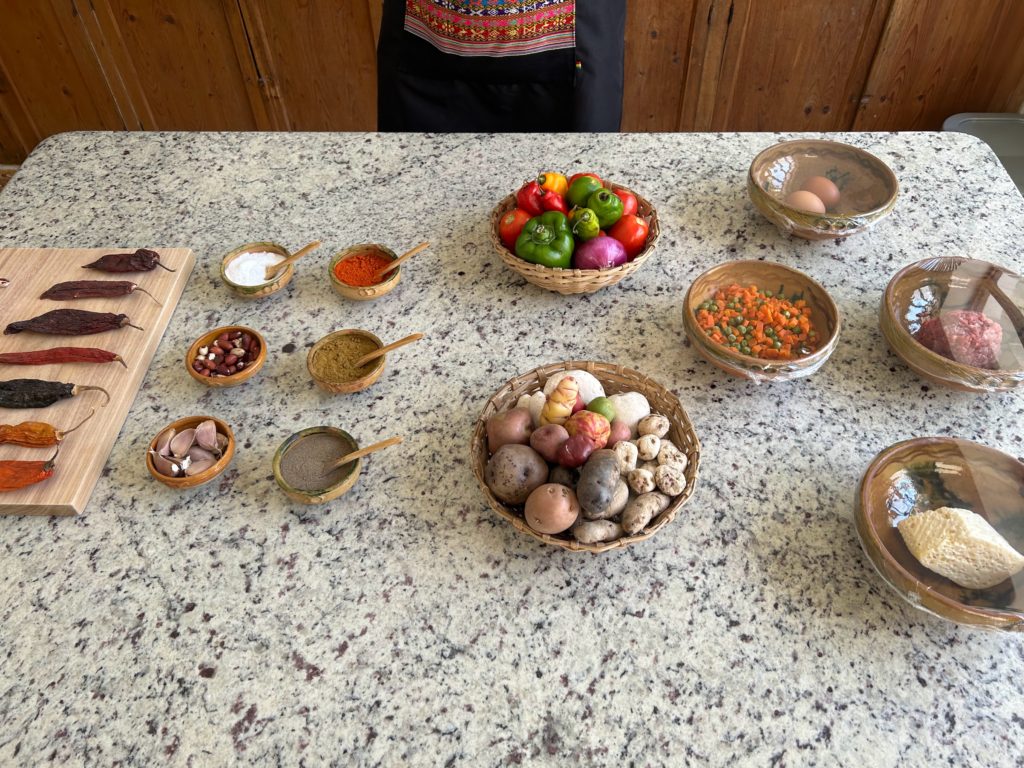
The cooking class started with an intro to some of the different ingredients we would be working with and others that are common to Bolivia. The most common ingredient would be “Aji”. Which is known as a spice derived from peppers (like paprika). In the photo above, the dried chilis are the aji and they are all different spice levels. When you grind them up, you get your spices. In the different regions of Bolivia, different amounts of spices are used. The most common spices are salt, pepper, and cumin. In Sucre, they use a lot of aji in the their food. The closest spice we have at home to pure aji would be paprika.
The other ingredient that is very common all over the Andes is potatoes. There are hundreds of varieties of potatoes. The Chef showed us a couple and and explained that to preserve the potatoes in the winder, they would dry them, like the chilis. The other ingredients are for the Papas Rellenas.
We started boiling some potatoes with some salt and then went to make a vegetable sauce. This sauce is very common to have with most dishes because it provides flavour and is cheap. The sauce was composed of onions, garlic, tomatoes, and green peppers. Chef told us that Bolivian’s only use vegetable oil because olive oil is for Europeans and is too expensive. We cooked down the vegetables and then added pepper, salt, cumin, and aji. We sauté everything until all the water in the tomatoes evaporates and its is about to burn. It is very important that it doesn’t burn or caramelize. Then you add a bunch of water and let the mixture reduce for at least an hour.
Then we started to make the filling for the Papas Rellenas. We browned the ground beef and then seasoned it with cumin, pepper, and salt and added the peas and carrots. We added some starchy water from the boiling potatoes. Once the water evaporated, we cooked it down and put it to the side. We peeled the eggs (they were boiled) and grated the cheese for other Papas Rellenas fillings.
Once the potatoes were done, we had to mash them quickly while they were still hot. We had to make sure they were no clumps because they will break when frying. To fill the papas, we take a layer of thin hot potatoes in the palm of your hand, then you put either half an egg, cheese, or the meat filling in the potato. Then cover with more potato and shape it. We all made one with each filling, expect Graham who made two egg ones because we got lost in translation (our Spanish still isn’t great).
The papas need to be fried but we were getting hungry so we moved on to making the appetizer, This was a very simple dish but it was delicious.
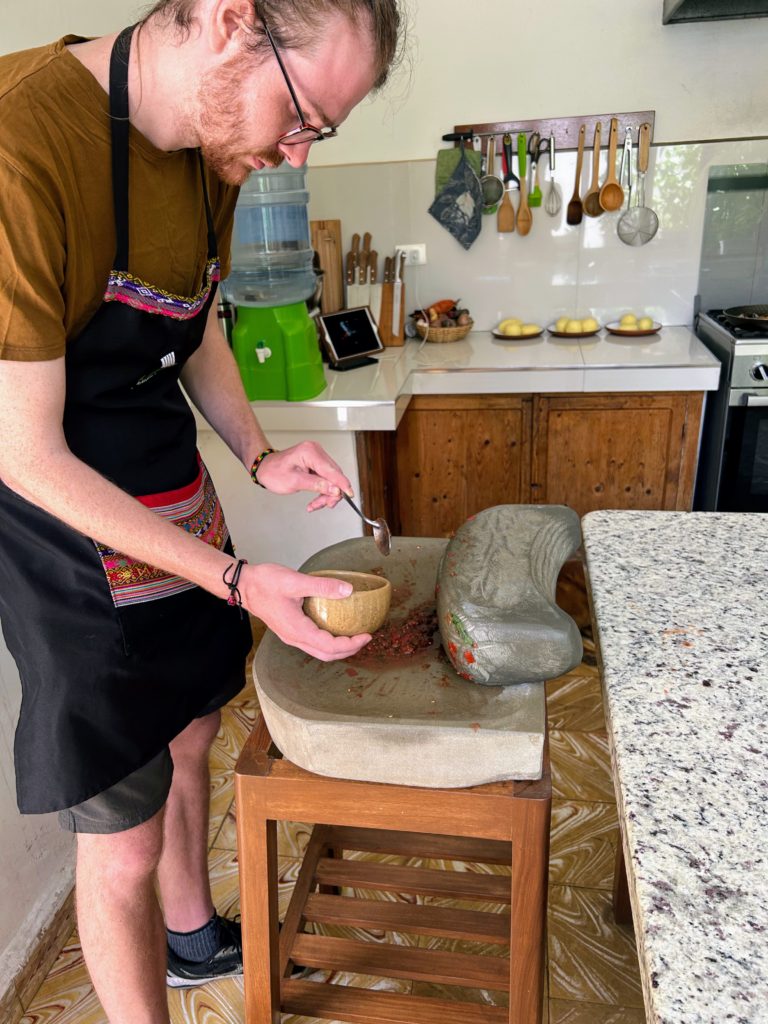
The big rock in the picture above is a traditional kitchen tool that Bolivian women use to mash food. Salsa is make everyday with these because they cannot afford kitchen tools and don’t use any preservatives so have to make daily.
Before we made the salsa, he asked us if we like spicy food and explained that the Bolivian flag, which is green, yellow, and red, symbolizes the different peppers that are commonly used and found in Bolivia. Green is not spicy, yellow is mild, and red is spicy. We tried the red pepper and though it was mild so we went full in with the red pepper.
We cut up tomato (in our hands because traditionally, Bolivian’s don’t have room in their houses for kitchen countertops), peppers and a leafy spice on the rock. The spice was growing in his garden and I (Camryn) think the spice tasted like a mix a mint and Thai basil but Graham thought it tasted like tarragon and something else he can’t place. Anyways, then you just wobble the rock and smash the ingredients and then make salsa.
We made a salad. We had a base of quinoa which we seasoned with lime juice, salt, and vegetable oil. Bolivians do not eat quinoa because it is twice as expensive as rice or pasta. So they export a lot of it. Our chef likes it and gringos like it.
If you haven’t guessed, Bolivia is a very poor. Because they are so poor, they eat 5 small meals a day. For breakfast, they will have a piece of bread and some tea. Then they have time to get the second meal made, which can be Papas Rellenas, salteña’s or boiled potatoes with the salsa. Then they will eat smaller meals throughout the day and they do not eat dessert. Bolivia does not have any popular desserts so they will just have fruit. We told Moises about butter tarts, pumpkin pie and Nanaimo bars)
We tired a variety of boiled potatoes, which we fried with some salt and oregano, yerba (a leafy herb from his garden), extra cheese, and some tomatoes. The second meals is typically eaten at 10am on a lunch break from work so we ate standing up. We put some salad on the side and it was delicious.
All the potatoes we tried were different. There was a soft sweet one, a purple one that was more starchy, and then a pink/orange one that was very crunchy. I will do my very best to try and replicate this salad when I get home.
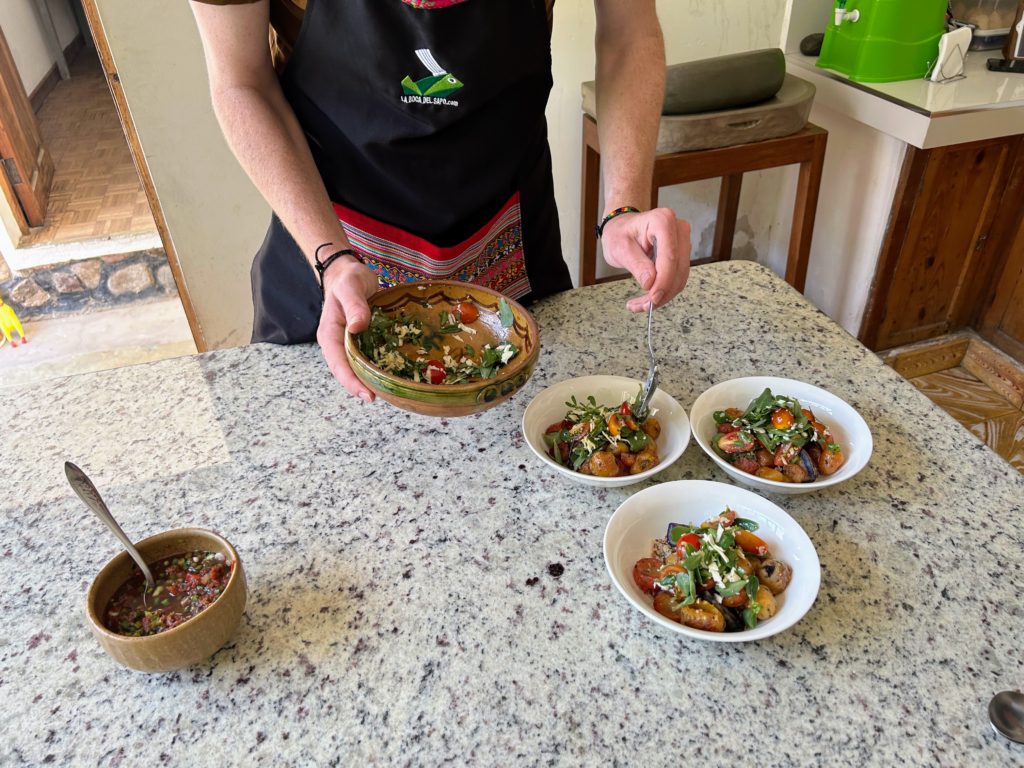
After our salad, It was time for a drink. The national alcohol of Bolivia is Singani. It is made from grapes and is is 40% alcohol. We made a nice cocktails with some fruit juice that was in season.
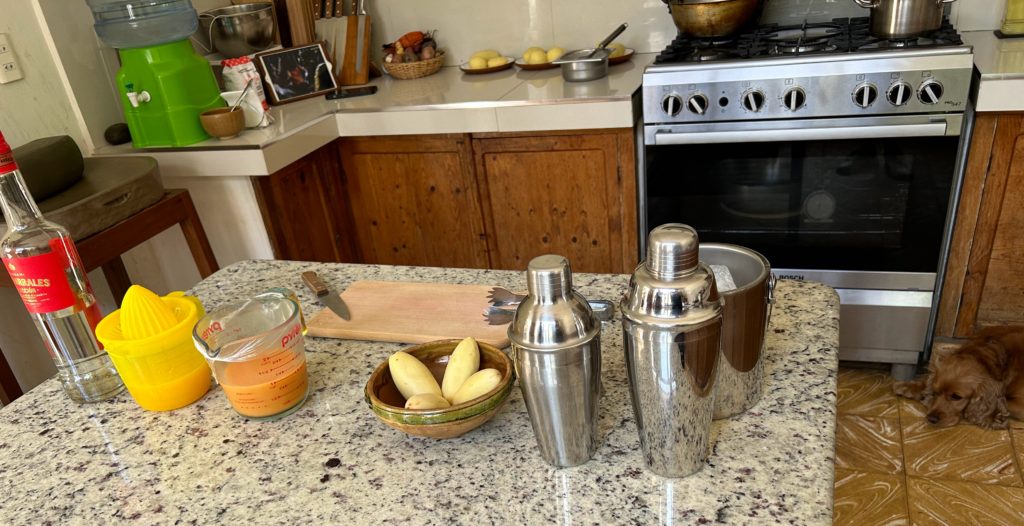
Graham juiced some oranges and tumbo. Tumbo is the fruit that looks like peeled potatoes in the pictures above. Tumbo is from the same family as passion fruit. It is very sour. We also added some red berry sugary syrup. It was a good drink. In the picture below, the garnish is the cross section of the tumbo.
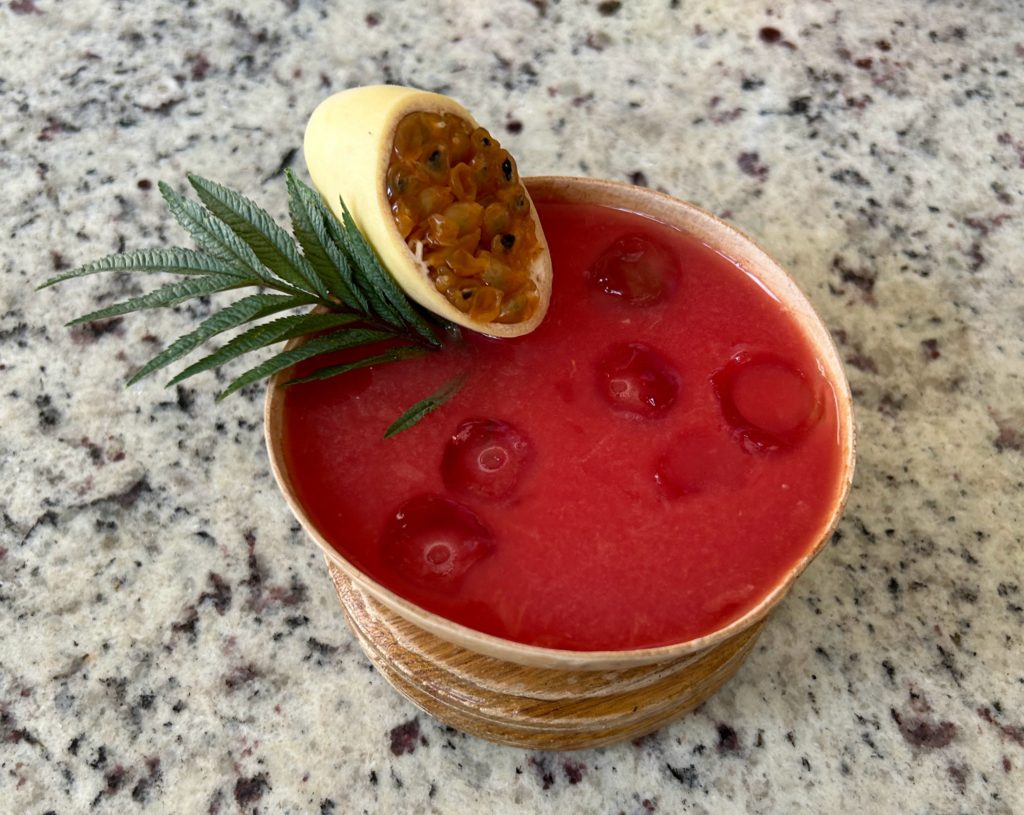
Once our drink were made, we made a quick batter so we could fry the Papas Rellenas. The batter had an egg, salt, aji, water, and flour. Now, we have to be very careful around this batter because the eggs in Bolivia have salmonella so you have to wash your hands and make sure your food is cooked. Anyways, you dunk the potatoes into the batter and then deep fry them. Once they cool, we plated them and covered them in the sauce that was simmering for the past two hours during the cooking class. Serve with mayo ( people in South America love mayo) and the spicy salsa.
The Papas Rellenas were decent. With the cheese and egg ones, they were essentially only cheese egg and potato. Which is good, but lacking in the spice department. The meat one was very similar to a shepherds pie, if in ball form. The spicy salsa made from the rock was delicious, and our simmering sauce gave a nice vegetable flavor.
Since Bolivians do not eat dessert, we made little fruit parfaits with some other local fruit. you can guess whos is whos.
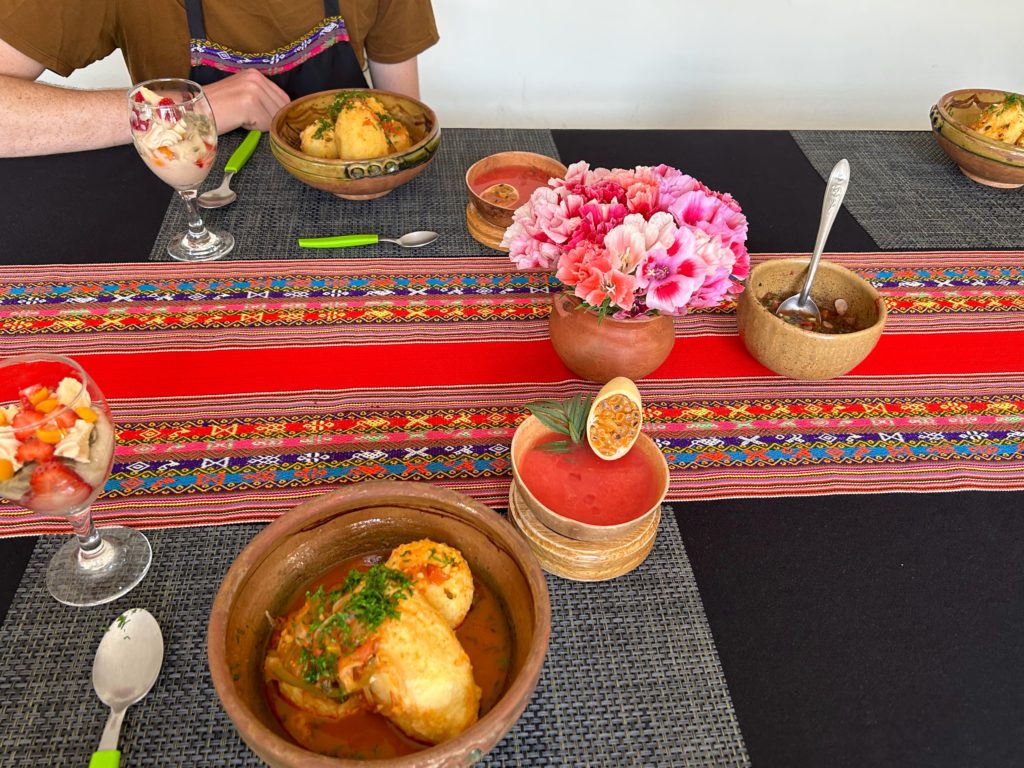
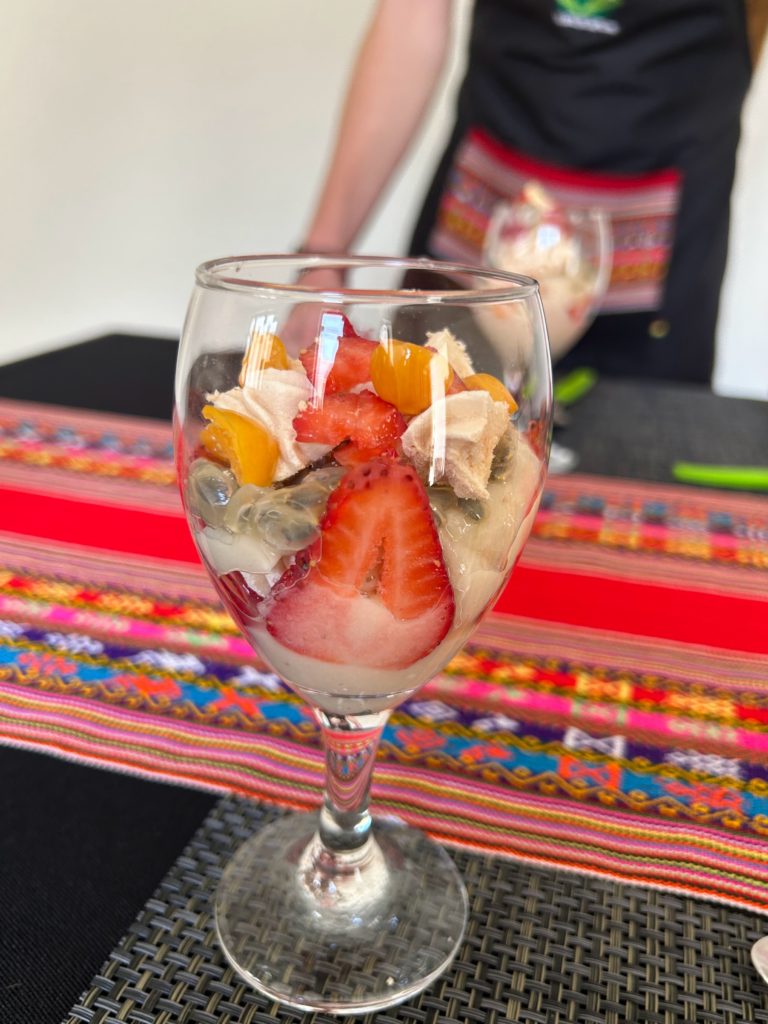
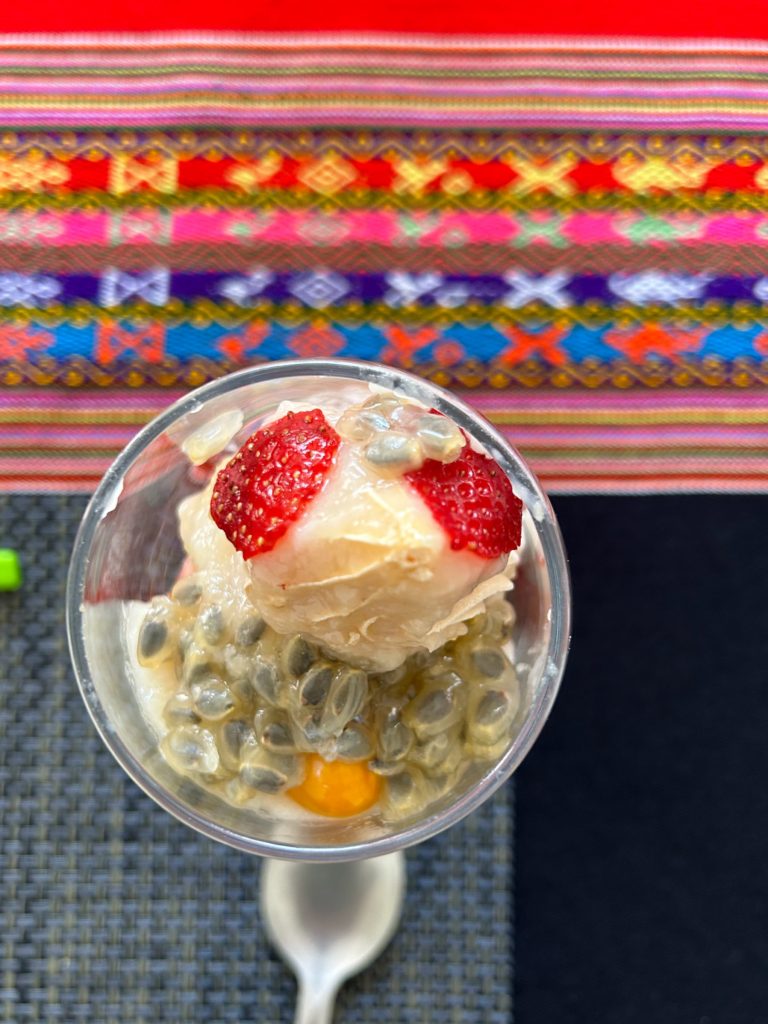

Overall, I think the food was okay. I think there is some great opportunities for us to fuse these Papas Rellenas with ingredients we have from home. But I do appreciate where the ingredients come from and how the food here is made from what people can afford. There are a lot of techniques that will be taken from this lesson and brought home. Many things will now be stuffed in mashed potatoes for everyone. I really like trying all the new ingredients and learning something new.

Well done exploring foreign food w such gusto, engaging w the local cultures is the treat of traveling. Yourselves do it well, Cook on!
YUM! Great cooking ideas. Thanks for the health lesson about eggs.
The food looks very fresh and authentic which it obvious was … which would be exactly what one would want to experience.
The variety of peppers looks fun and interesting. I would like to get better at knowing the different flavours different peppers provide and how to properly use them
Feel free to come home and teach me at your convenience.